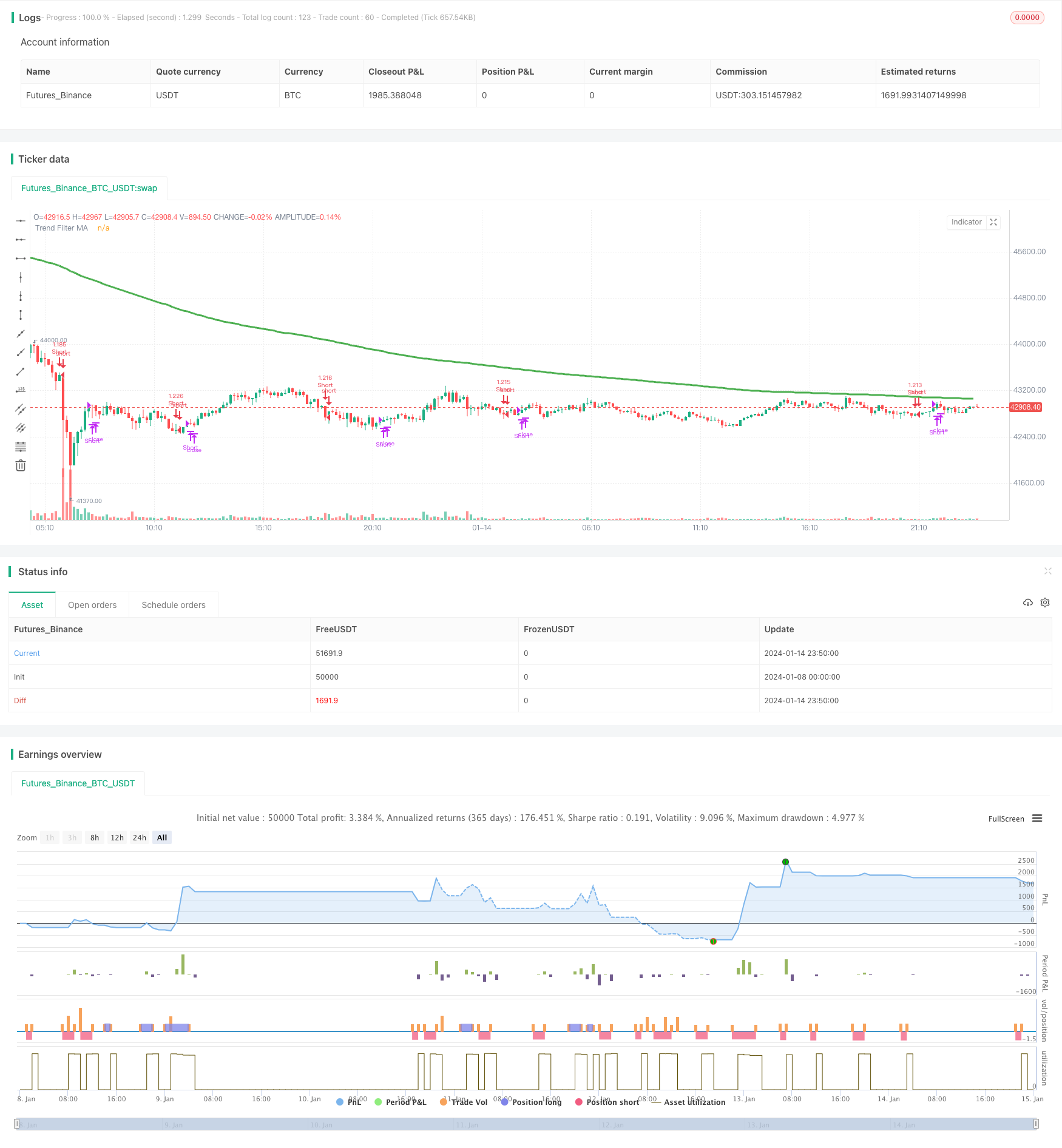ADXモメンタムトレンド戦略
作成日:
2024-01-16 15:57:17
最終変更日:
2024-01-16 15:57:17
コピー:
0
クリック数:
765
1
フォロー
1621
フォロワー

概要
この戦略は,ADX指数に基づいて市場のトレンドを判断し,DMI指数と組み合わせて多空方向を判断し,ADX斜率を使用してトレンドの強さを判断し,ADXのキー値を非トレンド市場をフィルタリングして,移動平均をフィルタリングする取引信号を補助する.
戦略原則
- ADX,DI+,DI−指標を計算する.
- ADX斜率>0は,トレンドの上昇を示し,キー値は23に設定され,非トレンド市場をフィルタリングする.
- DI+はDI−より高く,多頭力の空頭力より大きいことを示している.多頭信号を見る.
- 移動平均のフィルタを有効にすると,閉盘価格が移動平均より高い場合にのみ,多頭信号が生じます.
- ADX斜率時平仓すると,トレンドの消退を示している.
優位分析
- 補助MAフィルタは,トレンドでない市場のノイズ取引を減らすことができます.
- ADXの傾き判断は,トレンドの進行を正確に判断する.
- DIの判断はADXの判断と連携し,トレンド取引の意思決定システムに比喩的に整合した.
- 撤回と利益の比率は,単純な移動平均策よりも優れている.
リスク分析
- ADX指数は異なるパラメータを設定し,結果が大きく異なる.
- DMIは,多空方向を完全に決定していないので,誤った信号を発する可能性がある.
- 政策の落とし穴があるため 戦略の効果が低下している.
最適化の方向
- ADXパラメータの組み合わせを最適化し,最適なパラメータを探します.
- 単一損失の拡大を防ぐために,止損策を追加する.
- RSI,ブリン帯など,他の指標のフィルター信号と組み合わせてみてください.
要約する
この戦略は,ADXのトレンド判断とトレンド強さの優位性を最大限に活用し,DMI指標の判断方向と連携し,完全なトレンド追跡システムを形成します.同時に,移動平均は,非トレンド市場のノイズを効果的にフィルタリングすることができます.パラメータの最適化と指標の組み合わせは,戦略の安定性と効率性をさらに向上させることができます.全体的に,この戦略は,トレンド判断と方向判断の特性を組み合わせて,良いリターンを得ることを期待します.
ストラテジーソースコード
/*backtest
start: 2024-01-08 00:00:00
end: 2024-01-15 00:00:00
period: 10m
basePeriod: 1m
exchanges: [{"eid":"Futures_Binance","currency":"BTC_USDT"}]
*/
//@version=4
// This source code is subject to the terms of the Mozilla Public License 2.0 at https://mozilla.org/MPL/2.0/
// © millerrh with inspiration from @9e52f12edd034d28bdd5544e7ff92e
//The intent behind this study is to look at ADX when it has an increasing slope and is above a user-defined key level (23 default).
//This is to identify when it is trending.
//It then looks at the DMI levels. If D+ is above D- and the ADX is sloping upwards and above the key level, it triggers a buy condition. Opposite for short.
//Can use a user-defined moving average to filter long/short if desried.
// NOTE: THIS IS MEANT TO BE USED IN CONJUNCTION WITH MY "ATX TRIGGER" INDICATOR FOR VISUALIZATION. MAKE SURE SETTINGS ARE THE SAME FOR BOTH.
strategy("ADX | DMI Trend", overlay=true, initial_capital=10000, currency='USD',
default_qty_type=strategy.percent_of_equity, default_qty_value=100, commission_type=strategy.commission.percent, commission_value=0.04)
// === BACKTEST RANGE ===
From_Year = input(defval = 2019, title = "From Year")
From_Month = input(defval = 1, title = "From Month", minval = 1, maxval = 12)
From_Day = input(defval = 1, title = "From Day", minval = 1, maxval = 31)
To_Year = input(defval = 9999, title = "To Year")
To_Month = input(defval = 1, title = "To Month", minval = 1, maxval = 12)
To_Day = input(defval = 1, title = "To Day", minval = 1, maxval = 31)
Start = timestamp(From_Year, From_Month, From_Day, 00, 00) // backtest start window
Finish = timestamp(To_Year, To_Month, To_Day, 23, 59) // backtest finish window
// == INPUTS ==
// ADX Info
adxlen = input(14, title="ADX Smoothing")
dilen = input(14, title="DI Period")
keyLevel = input(23, title="Keylevel for ADX")
adxLookback = input(3, title="Lookback Period for Slope")
// == FILTERING ==
// Inputs
useMaFilter = input(title = "Use MA for Filtering?", type = input.bool, defval = true)
maType = input(defval="EMA", options=["EMA", "SMA"], title = "MA Type For Filtering")
maLength = input(defval = 200, title = "MA Period for Filtering", minval = 1)
// Declare function to be able to swap out EMA/SMA
ma(maType, src, length) =>
maType == "EMA" ? ema(src, length) : sma(src, length) //Ternary Operator (if maType equals EMA, then do ema calc, else do sma calc)
maFilter = ma(maType, close, maLength)
plot(maFilter, title = "Trend Filter MA", color = color.green, linewidth = 3, style = plot.style_line, transp = 50)
// Check to see if the useMaFilter check box is checked, this then inputs this conditional "maFilterCheck" variable into the strategy entry
maFilterCheck = if useMaFilter == true
maFilter
else
close
// == USE BUILT-IN DMI FUNCTION TO DETERMINE ADX AND BULL/BEAR STRENGTH
[diplus, diminus, adx] = dmi(dilen, adxlen)
buySignal = (adx[0]-adx[adxLookback] > 0) and adx > keyLevel and diplus > diminus and close >= maFilterCheck
// buySignalValue = valuewhen(buySignal, close, 0)
shortSignal = (adx[0]-adx[adxLookback] > 0) and adx > keyLevel and diplus < diminus and close <= maFilterCheck
// shortSignalValue = valuewhen(shortSignal, close, 0)
sellCoverSignal = adx[0]-adx[adxLookback] < 0
// == ENTRY & EXIT CRITERIA
// Triggers to be TRUE for it to fire of the BUY Signal : (opposite for the SELL signal).
// (1): Price is over the 200 EMA line. (EMA level configurable by the user)
// (2): "D+" is OVER the "D-" line
// (3): RSI 7 is under 30 (for SELL, RSI 7 is over 70)
// 1* = The ultimate is to have a combination line of 3 EMA values, EMA 14, EMA 50 and EMA 200 - And if price is over this "combo" line, then it's a strong signal
// == STRATEGY ENTRIES/EXITS ==
strategy.entry("Long", strategy.long, when = buySignal)
strategy.close("Long", when = sellCoverSignal)
strategy.entry("Short", strategy.short, when = shortSignal)
strategy.close("Short", when = sellCoverSignal)
// == ALERTS ==
// alertcondition(buySignal, title='ADX Trigger Buy', message='ADX Trigger Buy')
// alertcondition(sellSignal, title='ADX Trigger Sell', message='ADX Trigger Sell')